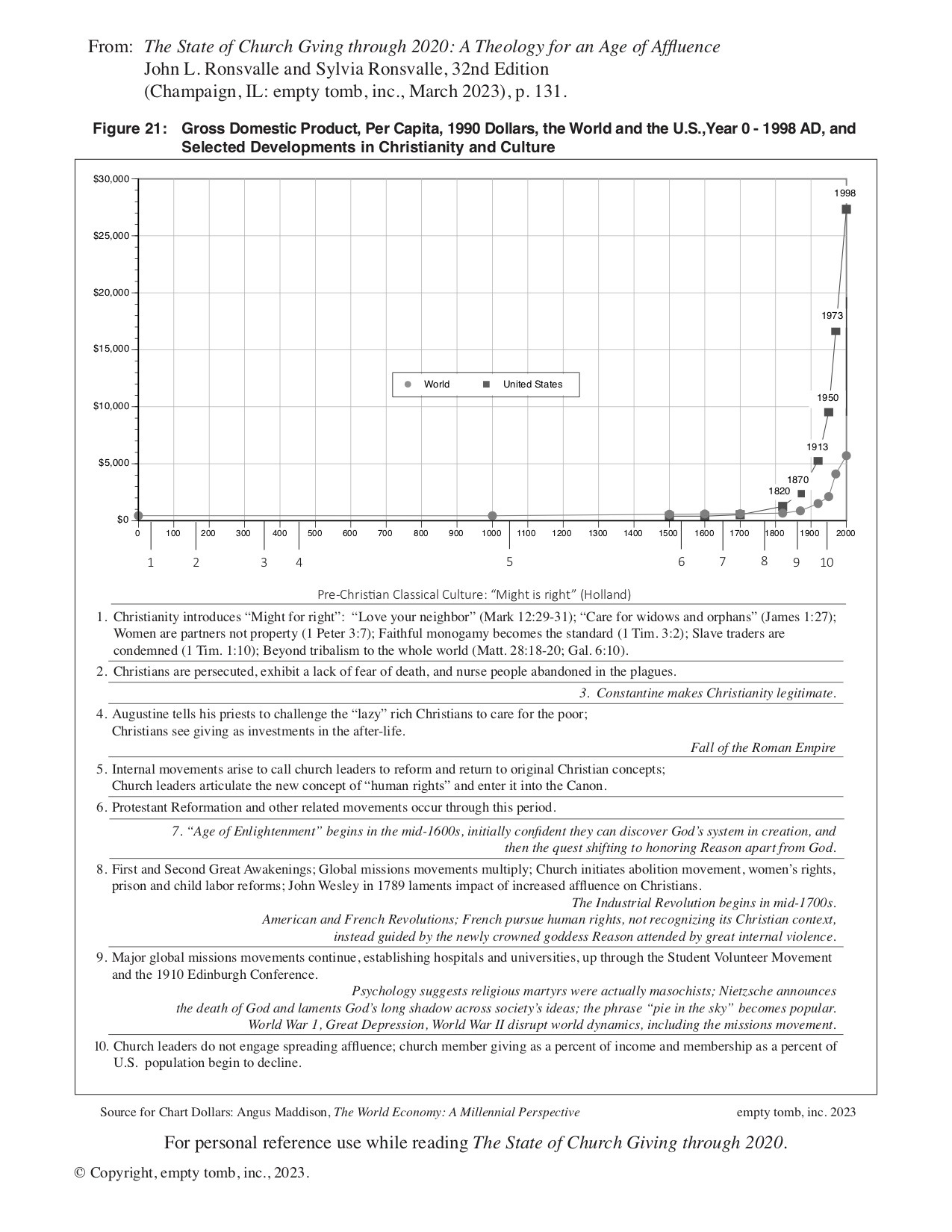Church Giving Down Again in 2020: Potential Remains Great: empty tomb's New The State of Church Giving through 2020, A Theology for an Age of Affluence
|

Click image for high resolution
|
NEWS PROVIDED BY
empty tomb, inc.
May 24, 2023
CHAMPAIGN, Ill., May 24, 2023 /Christian Newswire/ -- Church member giving as a percent of income was down again in 2020, according empty tomb's new edition, The State of Church Giving through 2020. What's needed to reverse the trend is summed up in the subtitle: A Theology for an Age of Affluence.
The data presented in the 32nd edition of the series shows that the downward trend in giving extends back to 1968.
Yet, according to the study's authors, the potential for church members to increase giving is great. And they write that a broad vision can serve as a positive agenda for the affluence that has been spreading in the U.S. since about 1820.
Other findings in the new book:
- The downward trend in the portion of income given to the church has been accompanied by a decline in the portion of church membership in the U.S. population.
- The downward giving trends are evident across the theological spectrum.
- Although more dollars were given by members, incomes increased faster. As a result, the dollars given represented a smaller part of available income. Further, of the increase in dollars given, the largest part stayed in the congregation to pay for operations.
- Of the money that comes into the church, an average of 2¢ of each dollar was forwarded by the congregations to the denominations' international mission outreach. This amount contrasts with an average of 8¢ in a group of 11 denominations from 1916 through 1927.
Yet, the new book's authors believe church members in the U.S. can use their potential for good.
- Churches still have some of the most effective communication systems and delivery networks that reach the neediest parts of the world.
- The church still claims one of the largest identity groups in the U.S., made up of a broadly-based constituency.
- The church has a clear and established framework that sets the expectation that members should use their power, in this case their financial resources, for the good of others.
- According to an analysis in the book of U.S. Bureau of Labor Statistics Consumer Expenditure Survey data for 2020, young people, in the Under-25 age group, again reported that the vast majority of their charitable giving – 81% in 2020 – went to "church, religious organizations." That suggests that religious settings are a key source of philanthropy education in young people.
So, how do the authors explain the disconnect between practice and potential?
The answer may be seen in the subtitle, A Theology for an Age of Affluence. Chapter 8 of the new book explores how church leaders can rethink the challenge they present to their members.
The first section of chapter 8 builds on the Angus Maddison analysis of per capita Gross Domestic Product from the Year 0 through 1998 AD. His analysis is in inflation-adjusted dollars. Numbers for the world (from the Year 0) and the U.S. (since 1500) are presented.
For example, in the year 1700, per capita GDP in the world was $625 and in the U.S., $527. By 1998, the world per capita GDP was $5,709 and the U.S. was $27,331, in 1990 inflation-adjusted dollars.
Ten points along the chart's Year 0 through 1998 AD axis explore various developments in the church and the world. One observation from these points is that, as people became increasingly affluent, they became more interested in their present existence. For example, the phrase "pie in the sky" was not coined until 1911.
The second section of the chapter observes trends in society that have accompanied a lack of a theology for an age of affluence offered by the church. Problems, such as increased violence, increased "deaths of despair" from drugs and alcohol, and increased youth mental health difficulties have been observed during the period that church member giving as a portion of income has declined. A table in this section quotes various church leaders concerned about the condition of the church.
The third section of chapter 8 considers elements of what might be included in a theology for an age of affluence. Eight topics, each built on a verse, are considered, for example: "Believe Jesus" (John 14:12); "More than consumers" (Romans 12:2); and "Created for a Purpose" (Eph. 2:8-10).
The authors suggest that the church needs to offer a positive agenda for the affluence that has been flooding – and overwhelming – U.S. society, including church members, beginning in about 1820.
The authors cite available documents about one of the worst ongoing emergencies in the world, which is the rate of children under the age of five dying from treatable causes. Three leading causes are pneumonia, diarrhea, and malaria. Neonatal deaths are a large percentage of the total number.
The authors suggest that church leaders could tap the imaginations of their members to meet this critical need. Potential resources of church members shared in Jesus' name through present delivery structures can help increase child survival.
The new book, The State of Church Giving through 2020: A Theology for an Age of Affluence, is the 32nd edition in the empty tomb series. The book is available from Wipf and Stock: (541) 344-1528 or info@wipfandstock.com.
SOURCE empty tomb, inc.
CONTACT: Sylvia Ronsvalle, 217-356-9519, research@emptytomb.org

